A visit to Jacobsen\'s HQ - The Lion Tour 2012
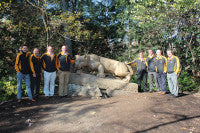 It was another typical wet November morning in the North West of England when six Golf Course Managers met up at Manchester Airport. David Cole (Loch Lomond GC), Stuart Yarwood (Lymm GC), Jeremy Hughes (Llangollen GC), Grant Peters (Linlithgow GC), Graeme Beatt (County Sligo GC) and I met up with Andy Campbell and David Timms of Ransomes Jacobsen. Andy is the company's Regional Sales Manager for Scotland and Ireland, whilst David is the Regional Sales Manager for the West of England and Wales.
It was another typical wet November morning in the North West of England when six Golf Course Managers met up at Manchester Airport. David Cole (Loch Lomond GC), Stuart Yarwood (Lymm GC), Jeremy Hughes (Llangollen GC), Grant Peters (Linlithgow GC), Graeme Beatt (County Sligo GC) and I met up with Andy Campbell and David Timms of Ransomes Jacobsen. Andy is the company's Regional Sales Manager for Scotland and Ireland, whilst David is the Regional Sales Manager for the West of England and Wales.
Andy and David had put together a ten day trip of the Mid-Atlantic region of the United States of America, and what a trip this was! Over the following week and a half we would take in US Open venues, factory tours and University trial plots, culminating in three days at the Penn State University Turf Grass Conference.
Our destination that morning was Charlotte, North Carolina, the home of Jacobsen's Headquarters in the US. The prospect of temperatures in the high teens was something to look forward to, not to mention a round of golf the following morning at Carmel Country Club to all get to know each other. This was a perfect setting to break the ice. The five star services at the private members club were second to none and the stunning course was the perfect back drop to kick off the Lion Tour 2012.
 Over the following day we had a fascinating tour of the facilities, including the production and manufacturing plants. Covering the vast expanse of factory floor were production lines for each of the models in the Jacobsen range. It was interesting to see the Jacobsen Eclipse start its life as a bare chassis, and then see wiring looms and engine added, along with its wheels and shell, to finally its logo and final checks.
Over the following day we had a fascinating tour of the facilities, including the production and manufacturing plants. Covering the vast expanse of factory floor were production lines for each of the models in the Jacobsen range. It was interesting to see the Jacobsen Eclipse start its life as a bare chassis, and then see wiring looms and engine added, along with its wheels and shell, to finally its logo and final checks.
Its journey didn't finish there. Each machine was then put through rigorous tests on a hydraulic machine to simulate travel over different terrain, with repeated lifting and lowering of their units. Once the machine had passed quality control it was ready for distribution.
A short drive across town brought us to an equally impressive site which was the parts and stock warehouse. Here, machines are sent out to dealers around the world and also where parts are distributed to the end users. A large team of staff manage over a million dollars worth of parts which can be shipped to all corners of the globe on an overnight postal services.
This visit concluded our short stay in North Carolina, as we flew out the next morning to Baltimore to visit Dr Peter Dernoeden at the turf grass trial plots at Maryland University.
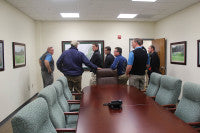 As we pulled into a gravel car park on the outskirts of the Maryland University Campus, in front of us was an area the size of a dozen football pitches, divided into trial plots devoted to research of turf grass used in golf and athletics fields.
As we pulled into a gravel car park on the outskirts of the Maryland University Campus, in front of us was an area the size of a dozen football pitches, divided into trial plots devoted to research of turf grass used in golf and athletics fields.
Dr Dernoeden is an expert on the management of creeping bentgrass; we would look forward to a lecture from him later in the week. First, he took us around extensive plots of creeping bentgrass cultivars established for fairways. Trials were looking at dollar spot and which cultivars showed a greater resistance to it. The new 007 cultivar certainly stood out, and is being used across this region.
Other areas were devoted to ryegrass cultivars for American football and 'soccer', as well as fairway overseeding during the winter months as, in this region, the Bermuda fairways go dormant and brown.
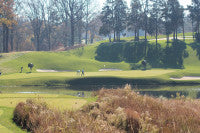 Turf Type Tall Fescue was being trialed extensively at different mowing heights. Trial work was also being conducted on this grass for ecological areas of golf courses and management guidelines recommended. We would later see this turf grass used on bunker banks at the 2013 US Open venue.
Turf Type Tall Fescue was being trialed extensively at different mowing heights. Trial work was also being conducted on this grass for ecological areas of golf courses and management guidelines recommended. We would later see this turf grass used on bunker banks at the 2013 US Open venue.
Departing Maryland, we headed for Washington DC and home of Rory Mclroy's triumphant US Open Victory at Congressional Country Club. The Director of Golf Course Maintenance, Michael Giuffre, welcomed us to his facility and gave us an extensive tour of his workshops and maintenance yard.
Michael has a great set up in immaculate order, yet he was envious of Merion's workshop, which we would call in to see the day after. In the meantime, we all boarded golf buggies and set off for a tour of the course, stopping off at signature holes and to discuss turf grass management in this part of the US.
For us, particular interest was in the large fans located at each green, as well as the sub-air system. Michael started up one of the fans and explained how, during the heat of summer and with high humidity, it was necessary to keep air movement over the turf surface to keep the plant alive. It was certainly interesting to see the different challenges Turf Grass Managers face in keeping a surface for golf.
We ended our tour on the tenth hole, outside the clubhouse, with a view across the lake to the 18th green jutting out into the water.
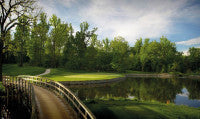 The afternoon was filled by a visit to another private members club called Chevy Chase Club (no connection to the National Lampoon actor). Here, Dean Graves CGCS took us around his superb course and facility. This layout and design reminded us a lot of a British-style golf course; we were also given a tour of its beautiful clubhouse, complete with outdoor ice rink for the winter months. The atmosphere at this club was very noticeable as a place for all the family. Children were playing on the grass or skating, whilst their parents played golf or tennis. They would then all meet for lunch or snacks. It is a wealthy place with a lot of tradition, but having fun seemed to be the key ingredient.
The afternoon was filled by a visit to another private members club called Chevy Chase Club (no connection to the National Lampoon actor). Here, Dean Graves CGCS took us around his superb course and facility. This layout and design reminded us a lot of a British-style golf course; we were also given a tour of its beautiful clubhouse, complete with outdoor ice rink for the winter months. The atmosphere at this club was very noticeable as a place for all the family. Children were playing on the grass or skating, whilst their parents played golf or tennis. They would then all meet for lunch or snacks. It is a wealthy place with a lot of tradition, but having fun seemed to be the key ingredient.
We couldn't be so close to the home of the recently re-elected President and not stop to take a look at the humble abode. So, en route to Philadelphia, we turned off to 1600 Pennsylvania Ave to photograph the White House. Election fever still gripped the Capitol, and it was also Veteran's Day, so the area was very busy with noticeable security on roof tops.
A three and a half hour drive saw us arrive in Philadelphia in time for our evening meal at a local steak house. Whilst we were on the theme of the US Open, it seemed right to call at Merion, the host club of this year's championship. We had been told that the course maintenance facility was special at Merion, and it didn't disappoint. $4 million has been spent in construction and equipping the facility.
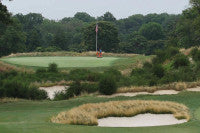 We were welcomed at reception by the Director of Golf Operations, Matt Shaffer, who introduced us to his secretary. We moved through a well-appointed office facility, including boardroom and offices for assistants, before a tour of the staff room and interns boarding rooms.
We were welcomed at reception by the Director of Golf Operations, Matt Shaffer, who introduced us to his secretary. We moved through a well-appointed office facility, including boardroom and offices for assistants, before a tour of the staff room and interns boarding rooms.
The area was kept immaculate, and the sense of pride was clear from all the staff. Whilst eating lunch as a greenkeeper at Merion, you are reminded daily of the tournament just around the corner, as a large clock is displayed prominently on the wall counting down to the US Open.
Matt continued his tour through the spacious garages and workshops, each dedicated to a specific operation, notably the chemical mixing tanks and spray facility. In one garage was a machine we all stood and marvelled at. Matt had designed and built his own ride-on fairway roller.  This was taking fairway management to a whole new level! He explained that his crew cut fairways, Monday, Wednesday and Friday, but rolled them the remaining four days, including the weekend. One wonders how many years it will be before this operation becomes an expected practice amongst golf's more prestigious venues?
This was taking fairway management to a whole new level! He explained that his crew cut fairways, Monday, Wednesday and Friday, but rolled them the remaining four days, including the weekend. One wonders how many years it will be before this operation becomes an expected practice amongst golf's more prestigious venues?
Out on the golf course we struggled to take in the sheer beauty of this layout. Merion has a distinct heathland feel, as fairways wind their way between occasional pines and large areas of broome. Irregular shaped bunkers with their banks allowed to grow wild enhanced this look.
Matt explained the fescue faces had not survived the heat of the summer, and the grounds crew were currently on a programme to replace the faces with turf type tall fescue. Their hard work was paying off as the bunkers did look stunning. We all commented how nice it was to see this style of bunker and not the manicured perfect edge, and how much more economical it would be to manage in terms of labour and time.
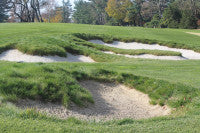 We visited Merion in mid-November and they too were moving into winter. The greens were being managed between two and three millimetres and would stay at that height all year round.
We visited Merion in mid-November and they too were moving into winter. The greens were being managed between two and three millimetres and would stay at that height all year round.
Both the US Open venues discussed, at length, that they managed their nutrient levels on the greens with spoon fed applications every ten days or so, depending on laboratory testing which they were able to do onsite. Merion will be a stern test for the players in this year's US Open, and I particularly look forward to watching them play the 265 yard par 3!
It was certainly interesting seeing these courses and learning about the management of them, marvelling at the couple of million dollars they have to spend on maintenance annually.
 You are left wondering what you can bring back to your home club, as we certainly don't have budgets of this magnitude. What struck us all were the little things around the staff room; notices reflecting staff birthdays, signs encouraging customer service, simply smile and say hello to members and make them welcome. Recipes for success such as "take pride in yourself and your work"; "bloom where you are planted"; and my favourite, "inspect, don't expect".
You are left wondering what you can bring back to your home club, as we certainly don't have budgets of this magnitude. What struck us all were the little things around the staff room; notices reflecting staff birthdays, signs encouraging customer service, simply smile and say hello to members and make them welcome. Recipes for success such as "take pride in yourself and your work"; "bloom where you are planted"; and my favourite, "inspect, don't expect".
These management tools don't cost pounds or dollars and, if UK facilities are going to survive and grow, we can certainly learn a lot from our American cousins about customer service and offering a greater experience beyond the condition of the course.
The Lion Tour 2012 concluded at Penn State University, home of the Nittany Lions. Jacobsen had very kindly enrolled us on the three day conference organised by John Kaminski and the Turf Grass Faculty at the university.
Over the final days we listened to well delivered talks, such as shade problems on Poa Annua greens by Karl Danneberger, and management of Creeping Bent by Dr Dernoeden. Curtis Tyrell gave us a superb presentation on preparing for and hosting the Ryder Cup at Medinah back in September.
A particularly poignant moment was the tribute to the late Stanley Zontek, who was a USGA agronomist for the Mid-Atlantic region and US Opens. He was a full-of-life character who had an infectious enthusiasm for our industry.
We couldn't spend a few days at Penn State and not take in the campus. If you are ever visiting, stop off at the creamery for an ice cream, I've never tasted better. We strolled down to the sports fields where baseball and 'soccer' pitches are dotted around the area.
 The skyline was dominated by the home ground of the college football team. The Beaver Stadium is the fourth largest stadium in the world, seating 110,000 fans. The kind staff at the stadium offered to take us into the stands to admire the football field. It is an amazing facility for a 'mere' college team, but then college football is big business and has a huge following.
The skyline was dominated by the home ground of the college football team. The Beaver Stadium is the fourth largest stadium in the world, seating 110,000 fans. The kind staff at the stadium offered to take us into the stands to admire the football field. It is an amazing facility for a 'mere' college team, but then college football is big business and has a huge following.
The ten day trip was drawing to a close. The thought of wet weather back home was not filling us with a desire to leave. We had crammed so much into our time and visited some truly amazing places. Like most places you visit, it's the people you meet that make the experience what it is. All eight of us in the group had got on so well, and we have now made new friends and colleagues in our industry.
It only remains for me, on behalf of the group, to thank Jacobsen for their hospitality, and also Andy and David for a most memorable trip.
